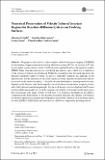Numerical preservation of velocity induced invariant regions for reaction-diffusion systems on evolving surfaces
Abstract
We propose and analyse a finite element method with mass lumping (LESFEM) for the numerical approximation of reaction–diffusion systems (RDSs) on surfaces in ℝ3 that evolve under a given velocity field. A fully-discrete method based on the implicit–explicit (IMEX) Euler time-discretisation is formulated and dilation rates which act as indicators of the surface evolution are introduced. Under the assumption that the mesh preserves the Delaunay regularity under evolution, we prove a sufficient condition, that depends on the dilation rates, for the existence of invariant regions (i) at the spatially discrete level with no restriction on the mesh size and (ii) at the fully-discrete level under a timestep restriction that depends on the kinetics, only. In the specific case of the linear heat equation, we prove a semi- and a fully-discrete maximum principle. For the well-known activator-depleted and Thomas reaction–diffusion models we prove the existence of a family of rectangles in the phase space that are invariant only under specific growth laws. Two numerical examples are provided to computationally demonstrate (i) the discrete maximum principle and optimal convergence for the heat equation on a linearly growing sphere and (ii) the existence of an invariant region for the LESFEM–IMEX Euler discretisation of a RDS on a logistically growing surface.
Citation
Frittelli , M , Madzvamuse , A , Sgura , I & Venkataraman , C 2018 , ' Numerical preservation of velocity induced invariant regions for reaction-diffusion systems on evolving surfaces ' , Journal of Scientific Computing , vol. First Online . https://doi.org/10.1007/s10915-018-0741-7
Publication
Journal of Scientific Computing
Status
Peer reviewed
ISSN
0885-7474Type
Journal article
Description
The authors (MF, AM, IS CV) would like to thank the Isaac Newton Institute for Mathematical Sciences for its hospitality during the programme [Coupling Geometric PDEs with Physics for Cell Morphology, Motility and Pattern Formation] supported by EPSRC Grant Number EP/K032208/1. MF’s and IS’s research work has been performed under the auspices of the Italian National Group for Scientific Calculus (GNCS-INdAM). This work (AM, CV) is partly supported by the EPSRC grant number EP/J016780/1 and the Leverhulme Trust Research Project Grant (RPG-2014-149). AM acknowledges funding from the European Union Horizon 2020 research and innovation programme under the Marie Skłodowska-Curie grant agreement No 642866.Collections
Items in the St Andrews Research Repository are protected by copyright, with all rights reserved, unless otherwise indicated.

